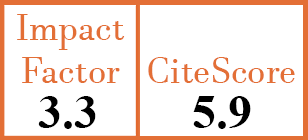Diagnosis
Interleukin-6 and soluble interleukin-6 receptor are elevated in large-vessel vasculitis: a cross-sectional and longitudinal study
L. Pulsatelli1, L. Boiardi2, E. Assirelli3, G. Pazzola4, F. Muratore5, O. Addimanda6, P. Dolzani7, A. Versari8, M. Casali9, L. Magnani10, E. Pignotti11, N. Pipitone12, S. Croci13, R. Meliconi14, C. Salvarani15
- Rizzoli Orthopaedic Institute, Bologna, Italy. lia.pulsatelli@ior.it
- Arcispedale Santa Maria Nuova-IRCCS, Reggio Emilia, Italy.
- Rizzoli Orthopaedic Institute, Bologna, Italy.
- Arcispedale Santa Maria Nuova-IRCCS, Reggio Emilia, Italy.
- Arcispedale Santa Maria Nuova-IRCCS, Reggio Emilia, Italy.
- Rizzoli Orthopaedic Institute, Bologna; and University of Bologna, Italy.
- Rizzoli Orthopaedic Institute, Bologna, Italy.
- Arcispedale Santa Maria Nuova-IRCCS, Reggio Emilia, Italy.
- Arcispedale Santa Maria Nuova-IRCCS, Reggio Emilia, Italy.
- Arcispedale Santa Maria Nuova-IRCCS, Reggio Emilia, Italy.
- Rizzoli Orthopaedic Institute, Bologna, Italy.
- Arcispedale Santa Maria Nuova-IRCCS, Reggio Emilia, Italy.
- Arcispedale Santa Maria Nuova-IRCCS, Reggio Emilia, Italy.
- Rizzoli Orthopaedic Institute, Bologna; and University of Bologna, Italy.
- Arcispedale Santa Maria Nuova-IRCCS, Reggio Emilia, Italy.
CER10105
2017 Vol.35, N°1 ,Suppl.103
PI 0102, PF 0110
Diagnosis
Free to view
(click on article PDF icon to read the article)
PMID: 28466804 [PubMed]
Received: 17/11/2016
Accepted : 13/02/2017
In Press: 20/04/2017
Published: 20/04/2017
Abstract
OBJECTIVES:
To investigate serum levels of IL- 6 and soluble IL-6 receptor (sIL-6R) in patients with large-vessel vasculitis and their relationship with disease activity.
METHODS:
Sera were obtained from 33 Takayasu’s arteritis (TAK) patients and 14 giant cell arteritis (GCA) patients, and from 60 age-matched normal controls (NCs). Disease activity was assessed using 18F-FDG PET/CT and clinical indices including NIH/Kerr criteria and ITAS. Among TAK patients with active disease at baseline, clinical records and serum samples from 11 TAK patients were available for the longitudinal study. IL-6 and sIL-6R serum levels were evaluated using commercial ELISA kits.
RESULTS:
IL-6 and sIL-6R serum levels were significantly higher in both GCA and TAK patients compared to NCs. IL-6 levels in TAK patients were significantly increased irrespective of disease phase, while a significant increase in sIL-6R concentrations was only found in TAK patients with active disease. Conversely, in GCA, IL-6 levels were significantly raised only in patients with active diseases, whereas sIL-6R levels appeared to be significantly higher irrespective of disease activity. Longitudinal analysis showed that levels of sIL-6R in TAK patients were significantly higher only at baseline, compared to NCs, whereas IL-6 levels were found to be significantly increased at each follow-up time point.
CONCLUSIONS:
These overall results might suggest a role for sIL-6R as a potential biomarker for disease activity in TAK patients, whereas in GCA, modifications of IL-6 might better identify patients with active disease.



